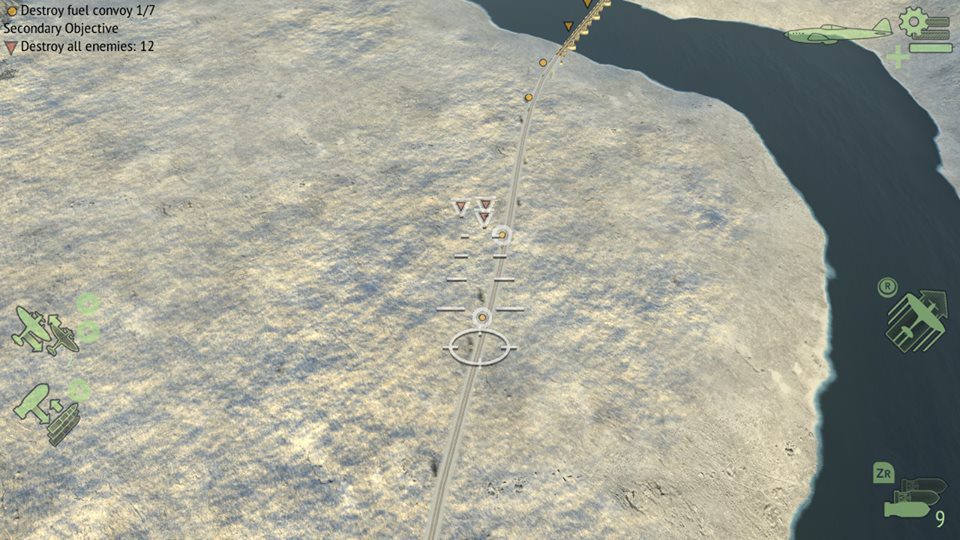“What do you get when you cross a World War 2 air combat game with a base management sim?” sounds like the kind of joke that features a punchline along the lines of “A visit from the marketing department and immediate revocation of your R&D funds.” However, Warplanes: WW2 Dogfight for the Nintendo Switch is far from a joke.
Originally an iOS and Android mobile game, the Nintendo Switch port of Warplanes removes any type of microtransaction gating from the game. Larger post-mission payouts allow players total freedom to play the game for whatever length play sessions they desire. When players start the game, they are immediately given a choice between three campaigns: Great Britain, Germany, and the U.S.S.R. All three campaigns can be in various stages of progress at any given time, and a resource sharing system enables the ability to transfer gold (the most valuable resource in the game) between campaigns.
Each campaign follows the same format: fly missions to earn resources, then spend those resources on various base features. There are base defenses to upgrade, new aircraft to purchase, skills to improve, existing aircraft to upgrade, and aircrew to hire and train. An option to set the radio chatter to the campaign language is a nice touch for a bit of immersion.
Missions come in four general formats: Offensive, Defensive, Naval, and Special. Each mission type provides a bonus allocation of one of the four base resources. Missions can be taken on alone, or with as many aircraft up to the squadron’s limits. Some missions, such as ground attack, really require multiple aircraft for successful completion, while others, such as defensive counter-air can be accomplished relatively easily with a single fully-upgraded fighter.
The mix of historical aircraft presents a good cross section of aircraft from all three available countries. Each campaign starts the player off with a single fighter and bomber available at the beginning of World War II, and provide a stable of purchasable aircraft which proceed all the way through the early jets available at the end of the war. All of the airplanes are well detailed, as befits their status as the stars of the game. Each aircraft can also be decorated with a range of colors and camouflage schemes, and a small selection of nose art.
Warplanes: WW2 Dogfight features one of the most simplistic flight models I’ve seen in an air combat game outside of arcade rail shooters such as Afterburner. Aircraft are limited in both pitch and roll angles, and the game includes a mystical ground repulsion field that prevents any attempts to tie the lowest altitude record. There are no options for loops, barrel rolls, or other familiar air combat maneuvers here. Dogfights are circular turning affairs where the name of the game is finding an enemy aircraft, locking on, and shooting until it explodes. An advanced difficulty mode allows players to turn off the auto-aim feature for some extra mission rewards, however given the general fiddliness of the small analog sticks on the JoyCons, most people will probably simply allow the auto-aim to do the heavy lifting, rather than spend minutes chasing a single enemy fighter.
The biggest issue with the game is in its repetition. As far as this writer can tell, there’s no end game to the campaigns. Maxxing out base building options is a relatively trivial activity, and after that the only remaining goals are to unlock all of the airplanes and chase various in-game achievements. Missions can vary a bit in terms of enemy types to be destroyed, but since (assuming identical upgrade levels) every bomber flies the same as every other bomber, and every fighter flies the same as every other fighter, there’s no particular excitement or danger in upgrading from say, a Supermarine Spitfire Mk. IX to a Gloster Meteor jet, or realizing that the next wave of enemy fighters isn’t another wing of Messerschmidt bf 109Gs but a flight of ME 262!
It’s hard to judge Warplanes too harshly as a bargain priced flight game on the Switch. There’s at least 5-6 hours of fun to be had with the game, and despite the repetition, the bite-sized missions (which rarely last more than five to ten minutes) make for a pleasant diversion over short play sessions. Essentially, it’s the best elements of the mobile game, expanded onto a larger screen and with better controls. Just don’t expect a narrative campaign or full flight model.
A copy of this game was provided for review.









